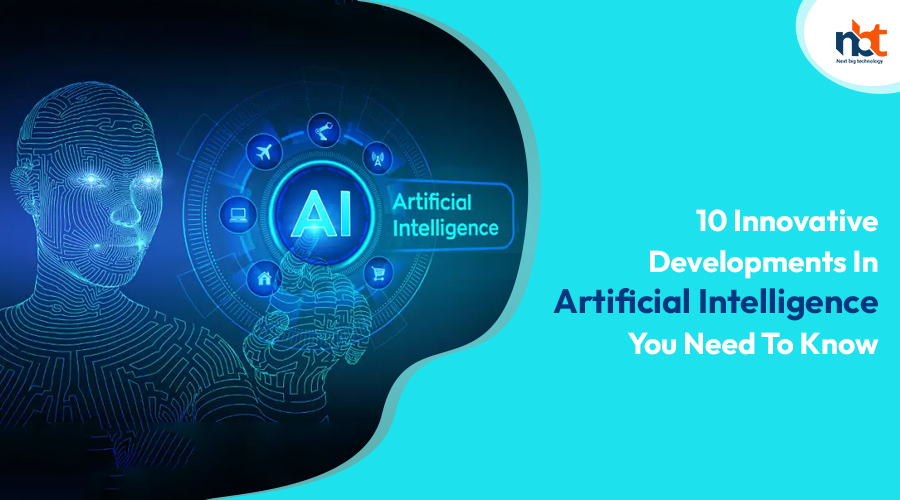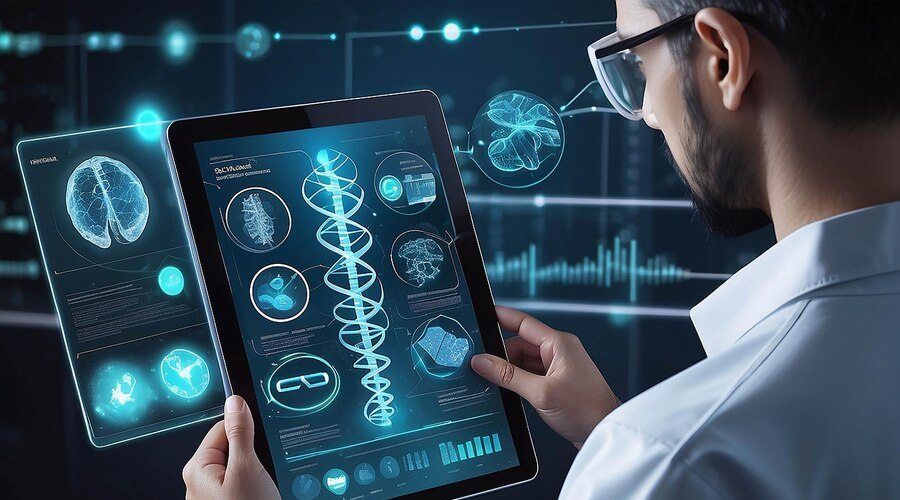Table of Contents
Breakthroughs in Natural Language Processing (NLP)
In the dynamic realm of technology, few domains have witnessed as rapid and transformative evolution as Natural Language Processing (NLP). From deciphering human language to powering virtual assistants and facilitating language translation, NLP has burgeoned into an indispensable tool reshaping human-machine interaction. Let’s delve into the fascinating breakthroughs propelling NLP into unprecedented realms of innovation.
Contextual Understanding: The Rise of Transformer Models
Central to the recent NLP breakthroughs is the advent of transformer models. These architectures, epitomized by BERT (Bidirectional Encoder Representations from Transformers) and GPT (Generative Pre-trained Transformer), revolutionized the field by enabling machines to comprehend language contextually. Unlike their predecessors, which struggled with contextual nuances, transformer models excel in understanding the intricacies of human speech, leading to remarkable advancements in sentiment analysis, language translation, and question-answering systems.
Zero-Shot Learning: GPT-3 and Beyond
At the forefront of NLP innovation stands GPT-3, a marvel of artificial intelligence boasting a staggering 175 billion parameters. What sets GPT-3 apart is its capability for zero-shot learning, enabling it to perform tasks without explicit training. This breakthrough eliminates the need for extensive data annotation, opening new vistas for rapid prototyping and deployment of NLP applications. With GPT-3, machines exhibit an unprecedented capacity to generate coherent text, engage in meaningful conversations, and even compose code, heralding a new era of human-AI collaboration.
Multimodal Fusion: Bridging Text and Images
In recent years, NLP has transcended linguistic boundaries to embrace multimodal fusion, integrating textual and visual information for enhanced understanding. Transformer models like CLIP (Contrastive Language-Image Pre-training) exemplify this paradigm shift, leveraging vast datasets to learn joint representations of text and images. This breakthrough paves the way for versatile applications, from image captioning and visual question answering to content recommendation systems tailored to individual preferences.
Ethical Considerations: Addressing Bias and Fairness
Amidst the euphoria surrounding NLP breakthroughs, ethical considerations loom large, prompting a concerted effort to address bias and ensure fairness in algorithmic decision-making. Researchers are actively developing techniques to mitigate biases ingrained in training data, promoting diversity and inclusivity in NLP models. Moreover, initiatives like the Responsible AI movement advocate for transparency and accountability, urging stakeholders to prioritize ethical considerations in the design and deployment of NLP systems.
Democratizing Access: Empowering Diverse Communities
As NLP technology advances, efforts to democratize access have gained momentum, aiming to empower diverse communities and bridge the digital divide. Open-source frameworks like Hugging Face and TensorFlow Hub democratize NLP research by providing accessible tools and pre-trained models to developers worldwide. Furthermore, initiatives like Fast.ai and AI for All advocate for inclusive education, equipping individuals from marginalized backgrounds with the skills to leverage NLP for social good.
Advancements in Generative Adversarial Networks (GANs)
Generative Adversarial Networks (GANs) have emerged as a revolutionary breakthrough in the realm of artificial intelligence, promising to reshape various industries with their ability to generate realistic data. Since their inception by Ian Goodfellow and his colleagues in 2014, GANs have undergone remarkable advancements, propelling them into the forefront of AI research and application. In this article, we delve into the significant strides made in the evolution of GANs, exploring how these advancements are redefining the boundaries of creativity and innovation.
The Birth of GANs: GANs, characterized by their unique architecture comprising a generator and a discriminator, were initially conceived with the aim of generating synthetic data that closely resembles real data distributions. This adversarial framework pits the generator against the discriminator in a game-like setting, wherein the generator aims to produce increasingly realistic samples, while the discriminator strives to differentiate between real and fake data. This adversarial process results in the refinement of both the generator and discriminator networks, leading to the generation of high-fidelity synthetic data.
Advancements in Training Techniques: Over the years, researchers have introduced several training techniques to enhance the stability and convergence of GANs. Techniques such as mini-batch discrimination, spectral normalization, and progressive growing have significantly improved the training process, enabling GANs to generate high-resolution images with greater consistency and realism. Moreover, the incorporation of regularization methods, such as Wasserstein distance and gradient penalty, has addressed issues related to mode collapse and vanishing gradients, further enhancing the performance of GAN models.
Unsupervised and Semi-Supervised Learning: One of the notable advancements in GANs is their application in unsupervised and semi-supervised learning tasks. Traditional GANs primarily focused on generating data in an unsupervised manner, without explicit labels. However, recent advancements have enabled GANs to leverage labeled data for semi-supervised learning, wherein the discriminator not only distinguishes between real and fake samples but also predicts class labels. This capability has broadened the scope of GANs, facilitating their utilization in various classification and data augmentation tasks.
Conditional Generation and Style Transfer: Conditional GANs have emerged as a powerful extension of GANs, allowing for the generation of data conditioned on specific attributes or labels. By conditioning the generator on additional information, such as class labels or input images, conditional GANs enable targeted generation of diverse outputs, ranging from text to images. Moreover, the concept of style transfer, popularized by techniques like CycleGAN and StyleGAN, enables the transformation of images between different artistic styles, paving the way for innovative applications in digital art and content creation.
Beyond Images: GANs in Diverse Domains: While GANs initially gained prominence in the domain of image generation, their applicability has transcended into diverse domains such as natural language processing (NLP), audio synthesis, and drug discovery. In NLP, techniques like Generative Pre-trained Transformer (GPT) have leveraged the GAN framework to generate coherent and contextually relevant text, advancing the capabilities of language generation models. Similarly, in drug discovery, GANs have been employed to generate novel molecular structures with desired properties, accelerating the process of drug development and optimization.
Quantum Computing’s Impact on AI
In the realm of technological innovation, two groundbreaking fields stand out: Quantum Computing and Artificial Intelligence (AI). While each has made remarkable strides independently, their convergence promises to redefine the boundaries of what we can achieve. Quantum computing’s impact on AI is not just a matter of evolution; it’s a paradigm shift with profound implications across industries and disciplines.
The Quantum Advantage: Quantum computing operates on principles vastly different from classical computing. While classical computers rely on bits as fundamental units of information (0s and 1s), quantum computers leverage quantum bits or qubits. Unlike classical bits, qubits can exist in multiple states simultaneously due to the phenomenon of superposition, exponentially increasing computational power.
This quantum advantage unlocks unprecedented potential for AI applications. Complex algorithms that would take classical computers years to solve can be executed exponentially faster by quantum computers. Tasks such as optimization, simulation, and pattern recognition—the backbone of AI—are expected to witness a quantum leap in efficiency and effectiveness.
Accelerating AI Innovation: One of the most significant impacts of quantum computing on AI lies in accelerating innovation. Training AI models, especially deep learning networks, is computationally intensive and time-consuming. With quantum computing, these processes can be expedited, enabling researchers to experiment with more complex models and datasets.
Moreover, quantum computing offers new avenues for developing AI algorithms. Quantum machine learning algorithms can harness the power of qubits to process vast amounts of data and identify intricate patterns that might remain hidden to classical algorithms. This opens doors to solving problems that were previously deemed intractable, from drug discovery to climate modeling.
Overcoming Computational Limits: Traditional computing faces inherent limitations in tackling certain AI challenges. For instance, the combinatorial explosion in optimization problems often hampers classical algorithms’ efficiency. Quantum computing, with its ability to explore multiple solutions simultaneously through quantum parallelism, presents a viable solution to such computational bottlenecks.
Furthermore, quantum computing can enhance AI’s capabilities in handling unstructured data. Natural language processing, sentiment analysis, and image recognition—areas where classical AI struggles—could witness significant advancements through quantum algorithms designed to process and interpret complex data patterns.
Addressing Ethical and Security Concerns: As quantum computing empowers AI with unprecedented capabilities, it also raises ethical and security concerns. The potential for quantum AI to crack existing encryption protocols poses a significant cybersecurity challenge. Researchers and policymakers must collaborate to develop quantum-resistant encryption methods to safeguard sensitive information in a post-quantum era.
Moreover, the ethical implications of quantum AI demand careful consideration. Ensuring fairness, transparency, and accountability in AI algorithms becomes even more crucial as their complexity increases. Responsible AI governance frameworks must evolve in tandem with technological advancements to mitigate potential risks and promote ethical AI deployment.
AI in Healthcare: Personalized Medicine and Diagnostics
In the realm of healthcare, the integration of artificial intelligence (AI) has sparked a revolutionary transformation. Among its myriad applications, one of the most promising areas is personalized medicine and diagnostics. This groundbreaking approach tailors medical treatments and diagnoses to individual characteristics, ushering in an era of targeted therapies and precise interventions.
AI algorithms, fueled by vast amounts of data, have the remarkable ability to analyze complex biological information swiftly and accurately. This capability is particularly valuable in understanding the unique genetic makeup, lifestyle factors, and environmental influences that contribute to an individual’s health profile. By discerning subtle patterns within these datasets, AI empowers healthcare professionals to make informed decisions personalized to each patient.
One of the most significant contributions of AI in personalized medicine is the refinement of treatment strategies. Traditional medical approaches often adopt a one-size-fits-all model, which may not fully accommodate the diverse needs of patients. However, AI-driven algorithms can analyze patient data to identify distinct subpopulations with varying responses to treatments. This enables healthcare providers to prescribe therapies that are not only effective but also tailored to the specific characteristics of each patient, optimizing outcomes while minimizing adverse effects.
Moreover, AI plays a pivotal role in diagnostics, revolutionizing the way diseases are detected and diagnosed. Through machine learning algorithms, AI can sift through vast volumes of medical imaging data, such as X-rays, MRIs, and CT scans, to identify abnormalities that might evade the human eye. By augmenting the expertise of healthcare professionals, AI enhances the accuracy and speed of diagnosis, facilitating early detection and intervention.
Furthermore, AI facilitates the development of predictive models that forecast disease progression and anticipate patient outcomes. By analyzing diverse datasets encompassing genetic, clinical, and environmental factors, AI algorithms can identify risk factors and biomarkers associated with various diseases. This proactive approach empowers healthcare providers to intervene preemptively, potentially preventing the onset or progression of illnesses before they manifest clinically.
The integration of AI in personalized medicine and diagnostics also holds the promise of enhancing healthcare accessibility and affordability. By streamlining processes, reducing diagnostic errors, and optimizing treatment regimens, AI has the potential to mitigate healthcare disparities and improve patient outcomes across diverse populations.
However, while the potential of AI in healthcare is immense, it is not without challenges. Privacy concerns, data security, and ethical considerations surrounding the use of patient information remain paramount. Additionally, the need for regulatory frameworks to govern the development and deployment of AI-powered healthcare solutions is crucial to ensure patient safety and trust in these technologies.
Autonomous Vehicles: Progress and Challenges
In the realm of transportation, the emergence of autonomous vehicles (AVs) stands as a testament to human ingenuity and technological advancement. These vehicles, once confined to the realm of science fiction, are now a tangible reality reshaping the future of mobility. As AV technology continues to evolve, it brings forth a landscape brimming with promise, yet not devoid of challenges.
Progress in Autonomous Vehicles:
1. Technological Advancements: The journey of AVs from concept to reality has been propelled by groundbreaking technological innovations. Machine learning algorithms, advanced sensors, and high-definition mapping have empowered these vehicles with the ability to perceive and navigate their surroundings autonomously. Companies at the forefront of AV development, such as Waymo, Tesla, and Uber, have made significant strides in refining these technologies, inching closer to achieving full autonomy.
2. Safety Improvements: One of the primary motivations behind the development of AVs is enhancing road safety. With human error accounting for the majority of accidents, autonomous systems promise a future where accidents are drastically reduced, if not eliminated altogether. The introduction of features like automatic emergency braking, adaptive cruise control, and lane-keeping assist in conventional vehicles serves as a precursor to the safety benefits AVs can offer.
3. Economic Opportunities: The advent of AVs brings with it a host of economic opportunities. From the potential to revolutionize public transportation and logistics to creating new markets for mobility services, the economic implications are vast. Moreover, AVs have the potential to enhance accessibility for individuals with disabilities or limited mobility, fostering a more inclusive transportation ecosystem.
Challenges Ahead:
1. Regulatory Hurdles: As AV technology continues to advance, regulatory frameworks struggle to keep pace. Questions surrounding liability, privacy, and ethical considerations pose significant challenges for policymakers. Achieving a balance between fostering innovation and ensuring public safety remains a delicate task, requiring collaboration between governments, industry stakeholders, and advocacy groups.
2. Ethical Dilemmas: The transition to autonomous driving raises complex ethical dilemmas that cannot be ignored. From decisions regarding how AVs prioritize the safety of occupants versus pedestrians to concerns about data privacy and cybersecurity, navigating these ethical minefields requires thoughtful deliberation and clear guidelines.
3. Infrastructure Integration: The widespread adoption of AVs necessitates robust infrastructure that can support their deployment. From the development of smart roads equipped with communication technologies to the establishment of charging stations for electric AVs, significant investments in infrastructure are required to realize the full potential of autonomous mobility.
AI in Finance: Predictive Analytics and Risk Management
In the dynamic realm of finance, staying ahead of the curve is paramount. With markets fluctuating at a rapid pace and risks lurking around every corner, the need for robust predictive analytics and risk management has never been more pronounced. Enter Artificial Intelligence (AI), a transformative force revolutionizing the financial landscape.
Gone are the days of traditional, static models struggling to keep pace with the intricacies of modern finance. AI, powered by machine learning algorithms and big data, offers a proactive approach to decision-making, enabling financial institutions to navigate uncertainty with confidence.
Predictive analytics lies at the heart of AI’s role in finance. By analyzing vast troves of historical and real-time data, AI algorithms can identify patterns, trends, and correlations that may elude human analysts. This capability empowers financial institutions to forecast market movements, customer behavior, and economic trends with unprecedented accuracy.
One of the key areas where AI excels is risk management. Traditional risk assessment methods often fall short in capturing the complex interplay of variables influencing financial markets. AI, on the other hand, thrives on complexity. By leveraging advanced statistical models and deep learning techniques, AI systems can assess risk factors in real-time, allowing institutions to proactively mitigate potential threats.
Moreover, AI enables the automation of routine tasks, freeing up human resources to focus on high-level strategic initiatives. From credit scoring and fraud detection to portfolio optimization and compliance monitoring, AI-driven solutions streamline processes, enhance efficiency, and reduce operational costs.
However, the adoption of AI in finance is not without its challenges. Data privacy concerns, algorithmic biases, and regulatory compliance remain significant hurdles that financial institutions must navigate. Moreover, the rapid pace of technological advancement necessitates continuous learning and adaptation to stay ahead of the curve.
Despite these challenges, the potential benefits of AI in finance are undeniable. By harnessing the power of predictive analytics and risk management, financial institutions can gain a competitive edge in an increasingly volatile market landscape. From identifying lucrative investment opportunities to safeguarding against potential risks, AI is reshaping the future of finance one algorithm at a time.
Robotics and Automation: Enhancing Industrial Processes
In the dynamic landscape of modern industry, robotics and automation have emerged as transformative forces, reshaping the way businesses operate and enhancing efficiency across various sectors. From manufacturing plants to logistics centers, the integration of robotic technology has revolutionized industrial processes, offering a plethora of benefits and opportunities for growth.
Automation, the use of control systems and information technologies to reduce the need for human intervention in processes, lies at the heart of this revolution. By automating repetitive tasks, businesses can streamline operations, minimize errors, and optimize production outputs. This not only leads to cost savings but also enhances the overall quality and consistency of manufactured goods.
One of the key advantages of robotics and automation is their ability to handle tasks that are too dangerous or labor-intensive for human workers. In hazardous environments such as chemical plants or nuclear facilities, robots can perform inspections, maintenance, and repairs without putting human lives at risk. Similarly, in industries with physically demanding tasks, such as heavy lifting or repetitive motions, automation can alleviate the burden on workers, reducing the risk of injuries and improving workplace safety.
Moreover, robotics and automation enable businesses to adapt to changing market demands with greater agility. With advanced sensors and data analytics, robotic systems can gather real-time information about production processes, allowing for quick adjustments and optimizations. This flexibility is particularly valuable in industries with fluctuating demand or short product lifecycles, where rapid reconfiguration of production lines is essential to staying competitive.
In addition to efficiency gains, robotics and automation also open up new possibilities for innovation and customization. Advanced robotics technologies, such as collaborative robots (cobots) equipped with artificial intelligence (AI) capabilities, are increasingly capable of learning and adapting to new tasks on the fly. This enables businesses to offer personalized products and services tailored to individual customer needs, driving customer satisfaction and loyalty.
Furthermore, the integration of robotics and automation into industrial processes has significant implications for the workforce. While some may fear job displacement, the reality is that automation tends to create new opportunities and roles, albeit with different skill requirements. Rather than replacing humans entirely, robots often augment human capabilities, allowing workers to focus on more complex and creative tasks that require human judgment and ingenuity.
However, it’s essential to recognize that the successful implementation of robotics and automation requires careful planning and investment. Businesses must consider factors such as technology compatibility, workforce training, and cybersecurity to ensure a smooth transition and maximize the benefits of automation.
AI in Agriculture: Precision Farming and Crop Monitoring
In the era of technological advancement, the integration of Artificial Intelligence (AI) in agriculture has emerged as a transformative force, reshaping traditional farming practices into precision-driven and efficient systems. Among its various applications, precision farming and crop monitoring stand out as game-changers, offering farmers unparalleled insights and control over their crops. Let’s delve into the profound impact of AI in revolutionizing agriculture through precision farming and crop monitoring.
Understanding Precision Farming: Precision farming, also known as precision agriculture, involves the use of advanced technologies to optimize crop yields while minimizing inputs such as water, fertilizer, and pesticides. AI plays a pivotal role in this process by analyzing vast amounts of data collected from various sources, including satellites, drones, sensors, and historical farm data.
AI-powered algorithms process this data to create detailed field maps, identifying variability in soil properties, moisture levels, and crop health. By precisely mapping these variations, farmers can implement site-specific management strategies, adjusting irrigation, fertilization, and pest control measures accordingly. This targeted approach not only maximizes yields but also minimizes environmental impact and input costs.
Crop Monitoring with AI: Effective crop monitoring is essential for early detection of pests, diseases, and nutrient deficiencies, enabling timely interventions to mitigate risks and optimize yields. AI-driven monitoring systems leverage machine learning algorithms to analyze imagery data captured by drones, satellites, or ground-based sensors.
These algorithms can distinguish between healthy and distressed crops, detect pest infestations, and predict yield outcomes with remarkable accuracy. By continuously monitoring crop health and growth patterns, farmers can proactively address emerging issues, optimizing resource allocation and ensuring optimal harvest outcomes.
Benefits of AI in Agriculture: The integration of AI in precision farming and crop monitoring offers a plethora of benefits for farmers and the environment:
- Increased Yield and Profitability: By optimizing inputs and management practices, AI-driven precision farming can significantly increase crop yields and profitability.
- Resource Efficiency: Precise resource management reduces water, fertilizer, and pesticide usage, minimizing environmental impact and conserving resources.
- Early Detection of Issues: AI-powered crop monitoring enables early detection of pests, diseases, and nutrient deficiencies, allowing prompt intervention and mitigation.
- Data-Driven Decision Making: Access to real-time data and actionable insights empowers farmers to make informed decisions, improving productivity and resilience in the face of environmental challenges.
- Sustainable Agriculture: By promoting efficient resource usage and reducing chemical inputs, AI-enabled agriculture contributes to sustainable farming practices and environmental stewardship.
Challenges and Future Directions: Despite its transformative potential, the widespread adoption of AI in agriculture faces several challenges, including access to technology, data privacy concerns, and the need for farmer education and training. Addressing these challenges requires concerted efforts from policymakers, technology developers, and agricultural stakeholders.
Looking ahead, the future of AI in agriculture is promising, with ongoing advancements in sensor technology, robotics, and data analytics. By leveraging these innovations, we can further enhance the efficiency, productivity, and sustainability of farming operations, ensuring food security for future generations.
Human-AI Collaboration: Augmenting Human Abilities
In the age of rapid technological advancement, the relationship between humans and artificial intelligence (AI) has evolved into a dynamic partnership, characterized by collaboration rather than competition. This synergy between human intellect and machine learning capabilities has opened up a realm of possibilities, leading to significant enhancements across various domains. From healthcare to finance, from manufacturing to creative industries, the amalgamation of human expertise with AI algorithms is reshaping the way we work, create, and innovate.
Unleashing Creativity with AI
One of the most profound impacts of human-AI collaboration is evident in the realm of creativity. Traditionally, creativity was perceived as an inherently human trait, driven by intuition, emotion, and imagination. However, AI has challenged this notion by demonstrating its ability to generate novel ideas, designs, and artistic creations. Whether it’s composing music, producing artwork, or crafting literature, AI algorithms can analyze vast datasets, identify patterns, and generate innovative content that complements human creativity. Far from replacing human artists, AI serves as a tool for inspiration, exploration, and amplification, augmenting our creative abilities and pushing the boundaries of artistic expression.
Enhancing Decision-Making in Healthcare
In healthcare, the collaboration between humans and AI has revolutionized the diagnostic and treatment process. With access to extensive medical databases and advanced machine learning algorithms, AI systems can analyze medical images, interpret diagnostic tests, and identify patterns indicative of diseases with remarkable accuracy. By assisting healthcare professionals in diagnosing illnesses, predicting patient outcomes, and personalizing treatment plans, AI augments the capabilities of medical practitioners, enabling them to make more informed decisions and deliver better patient care. This synergy between human expertise and AI intelligence has the potential to improve healthcare outcomes, enhance efficiency, and save lives.
Transforming Customer Service and Support
In the realm of customer service and support, AI-powered chatbots and virtual assistants have become invaluable assets for businesses seeking to enhance their customer experience. By leveraging natural language processing and machine learning algorithms, these AI systems can engage with customers in real-time, answer inquiries, resolve issues, and provide personalized recommendations. While human agents excel in empathy, intuition, and complex problem-solving, AI complements their abilities by handling routine queries, automating repetitive tasks, and streamlining customer interactions. This collaborative approach not only improves efficiency and responsiveness but also frees up human agents to focus on high-value tasks that require emotional intelligence and critical thinking.
Fostering Innovation in Research and Development
In research and development (R&D), the collaboration between humans and AI is driving breakthroughs across diverse fields, from pharmaceuticals to materials science. AI algorithms can sift through vast amounts of data, identify correlations, and predict outcomes with unprecedented speed and accuracy. By augmenting human researchers’ capabilities, AI accelerates the process of discovery, enabling scientists to explore new hypotheses, design experiments, and uncover insights that would have been otherwise elusive. Whether it’s drug discovery, genome sequencing, or materials design, the synergy between human ingenuity and AI algorithms is fueling innovation and advancing the frontiers of knowledge.
AI in Education: Adaptive Learning and Personalized Tutoring
AI in Education: Adaptive Learning and Personalized Tutoring
In recent years, the integration of Artificial Intelligence (AI) into the educational sector has revolutionized how students learn and interact with academic content. AI-driven adaptive learning and personalized tutoring systems are at the forefront of this transformation, promising to enhance the educational experience for students of all ages.
Understanding Adaptive Learning
Adaptive learning refers to educational technologies that modify the delivery of course material based on individual student needs. These systems analyze a student’s performance in real-time, identifying strengths and weaknesses to tailor the learning process accordingly. This customization ensures that each student receives a unique educational experience designed to maximize their learning potential.
The key to adaptive learning is its ability to collect and analyze data. Advanced algorithms assess various metrics, including how long a student takes to answer questions, the accuracy of their responses, and their engagement levels. Based on this data, the system adjusts the difficulty of the content, offers additional resources, or even changes the teaching strategy to better suit the learner’s needs.
Personalized Tutoring: The Next Step in Education
Personalized tutoring takes adaptive learning a step further by providing one-on-one educational support tailored to the individual student’s learning style, pace, and preferences. AI-powered personalized tutors simulate the benefits of human tutors through sophisticated algorithms and natural language processing capabilities.
These AI tutors can interact with students in a conversational manner, providing explanations, answering questions, and offering encouragement. They are available 24/7, making it easier for students to access help whenever they need it. Moreover, personalized tutoring systems can monitor student progress over time, continuously adapting to provide the most effective support.
Benefits of AI in Education
- Enhanced Learning Outcomes: Adaptive learning systems ensure that students are neither bored by content that is too easy nor overwhelmed by content that is too difficult. This balance helps maintain student engagement and improves overall learning outcomes.
- Individualized Learning Paths: AI in education allows for the creation of individualized learning paths, accommodating diverse learning styles and paces. This personalized approach helps students grasp complex concepts more effectively.
- Immediate Feedback: AI-powered systems provide immediate feedback, enabling students to correct mistakes and understand concepts in real-time. This instant feedback loop is crucial for reinforcing learning and maintaining student motivation.
- Accessibility: AI tutoring systems make high-quality educational support accessible to a broader audience, including those who may not have access to traditional tutoring due to geographical or financial constraints.
- Teacher Support: AI can handle administrative and repetitive tasks, freeing up teachers to focus on more critical aspects of education, such as student engagement and curriculum development. Teachers can also use data from AI systems to better understand their students’ needs and tailor their instruction accordingly.
Challenges and Considerations
While the benefits of AI in education are significant, there are challenges to consider. Privacy concerns arise from the extensive data collection necessary for these systems to function effectively. Ensuring that student data is protected and used ethically is paramount. Additionally, there is a risk of over-reliance on technology, which could potentially devalue the importance of human interaction in education.
Furthermore, the effectiveness of AI in education depends on the quality of the algorithms and the accuracy of the data they process. Continuous improvement and rigorous testing of these systems are essential to ensure they meet educational standards and genuinely benefit students.
The Future of AI in Education
The future of AI in education looks promising, with advancements in machine learning and data analytics paving the way for even more sophisticated adaptive learning and personalized tutoring systems. As technology evolves, we can expect these systems to become more intuitive, offering deeper insights into student learning and providing even more effective support.
Top 10 Innovative Developments In Artificial Intelligence Companies
Artificial Intelligence (AI) is transforming industries, from healthcare to finance, by introducing unprecedented efficiencies and capabilities. As AI technology evolves, companies at the forefront of this revolution are pioneering developments that shape the future. Here are the top 10 innovative developments in AI companies that are making waves in 2024.
-
Next Big Technology:

Focus Area
- Mobile App Development
- App Designing (UI/UX)
- Software Development
- Web Development
- AR & VR Development
- Big Data & BI
- Cloud Computing Services
- DevOps
- E-commerce Development
Industries Focus
- Art, Entertainment & Music
- Business Services
- Consumer Products
- Designing
- Education
- Financial & Payments
- Gaming
- Government
- Healthcare & Medical
- Hospitality
- Information Technology
- Legal & Compliance
- Manufacturing
- Media
2. DeepMind’s AlphaFold: Advancing Medical Research DeepMind’s AlphaFold has made significant strides in predicting protein structures, a breakthrough that accelerates drug discovery and disease understanding. This AI development addresses one of biology’s biggest challenges, potentially leading to treatments for various diseases and revolutionizing bioengineering.
3. IBM Watson: Enhancing Business Decision-Making IBM Watson continues to innovate in AI by integrating machine learning with business analytics. Its capabilities in natural language processing and data analysis provide actionable insights, helping businesses make informed decisions. Watson’s applications range from customer relationship management to financial forecasting.
4. Tesla’s Full Self-Driving (FSD) Software: Pioneering Autonomous Vehicles Tesla’s FSD software is pushing the boundaries of autonomous driving. Utilizing a sophisticated suite of AI algorithms and real-time data processing, Tesla aims to create vehicles that can navigate complex urban environments safely. This technology promises to reduce traffic accidents and improve transportation efficiency.
5. NVIDIA’s AI Platforms: Powering Deep Learning NVIDIA’s AI platforms are critical for training and deploying deep learning models. Their GPUs and AI-specific hardware accelerate computations required for complex AI tasks. NVIDIA’s advancements in AI hardware enable faster development cycles and more powerful AI applications across various industries.
6. Google DeepMind’s Reinforcement Learning: Improving AI Training Google DeepMind continues to lead in reinforcement learning, a type of machine learning where an agent learns by interacting with its environment. Their innovations have improved AI training efficiency and performance, finding applications in robotics, gaming, and real-world problem-solving scenarios like logistics and resource management.
7. Amazon Web Services (AWS) AI: Democratizing AI Access AWS AI services are making AI accessible to businesses of all sizes. With tools like SageMaker, AWS provides comprehensive solutions for building, training, and deploying machine learning models. This democratization of AI technology empowers startups and enterprises to innovate without needing extensive AI expertise.
8. Baidu’s Ernie: Advancing Chinese NLP Baidu’s Ernie has made significant progress in Chinese natural language processing. By leveraging extensive pre-training and fine-tuning techniques, Ernie can understand and generate complex Chinese text. This development enhances applications in translation, customer service, and content generation for Chinese-speaking markets.
9. Microsoft Azure AI: Integrating AI with Cloud Computing Microsoft Azure AI integrates AI capabilities with cloud computing services, providing scalable and efficient solutions for businesses. Azure’s AI services include machine learning, cognitive services, and bot services, which streamline the development of intelligent applications across various industries.
10. Palantir Foundry: Transforming Data into Insights Palantir Foundry uses AI to transform large datasets into actionable insights. This platform allows organizations to integrate, manage, and analyze data seamlessly, facilitating better decision-making and operational efficiency. Palantir’s AI-driven data analytics is particularly impactful in sectors like defense, healthcare, and finance.
FAQs On 10 Innovative Developments In Artificial Intelligence
Artificial Intelligence (AI) continues to revolutionize the world, impacting various sectors and industries with its innovative developments. This article addresses frequently asked questions about the top 10 groundbreaking advancements in AI, providing insights into their significance, applications, and future potential.
1. What is Explainable AI (XAI)?
Explainable AI (XAI) refers to AI systems designed to make their decision-making processes understandable to humans. Traditional AI models, especially deep learning networks, often function as “black boxes,” making it difficult to interpret their decisions. XAI aims to bridge this gap by providing clear, interpretable explanations.
Benefits of XAI
- Transparency: Enhances trust in AI by making its operations transparent.
- Accountability: Facilitates the identification of errors and biases.
- Regulatory Compliance: Helps meet legal and ethical standards for AI deployment.
2. How is AI Enhancing Natural Language Processing (NLP)?
Natural Language Processing (NLP) is a field focused on the interaction between computers and human language. AI advancements have significantly improved NLP, enabling machines to understand, interpret, and generate human language with high accuracy.
Key Developments in NLP
- Language Models: Innovations like GPT-4 offer more nuanced and context-aware text generation.
- Sentiment Analysis: Improved algorithms can better gauge the emotional tone of text.
- Machine Translation: AI-driven translation tools are becoming more precise and reliable.
3. What Are AI-Powered Personal Assistants?
AI-powered personal assistants, such as Siri, Alexa, and Google Assistant, leverage AI to perform tasks, answer queries, and manage schedules using voice commands.
Advantages of AI Personal Assistants
- Convenience: Automates routine tasks, saving time and effort.
- Integration: Seamlessly connects with various smart home devices and services.
- Personalization: Learns user preferences to provide tailored experiences.
4. What is the Role of AI in Autonomous Vehicles?
AI is at the core of autonomous vehicles, enabling cars to navigate, make decisions, and drive without human intervention.
AI Applications in Autonomous Vehicles
- Computer Vision: Uses cameras and sensors to perceive surroundings.
- Decision Making: Algorithms process real-time data to make driving decisions.
- Predictive Maintenance: AI predicts and prevents vehicle breakdowns.
5. How is AI Transforming Healthcare?
AI is revolutionizing healthcare by improving diagnostics, treatment planning, and patient care.
AI in Healthcare Innovations
- Medical Imaging: AI enhances the accuracy of image analysis for disease detection.
- Predictive Analytics: Anticipates patient health issues and suggests preventive measures.
- Personalized Medicine: Tailors treatments based on individual genetic profiles.
6. What is AI-Driven Cybersecurity?
AI-driven cybersecurity involves using AI to detect, prevent, and respond to cyber threats more efficiently than traditional methods.
Benefits of AI in Cybersecurity
- Threat Detection: Identifies unusual patterns and potential threats in real-time.
- Response Automation: Quickly reacts to security breaches, minimizing damage.
- Vulnerability Management: Continuously scans and patches system vulnerabilities.
7. How Does AI Impact Financial Services?
AI is transforming financial services by enhancing decision-making, improving customer service, and increasing operational efficiency.
AI Applications in Finance
- Fraud Detection: Identifies fraudulent transactions using advanced pattern recognition.
- Algorithmic Trading: Executes trades based on AI-driven strategies.
- Customer Support: AI chatbots provide instant assistance and support.
8. What is AI in Robotics?
AI in robotics involves integrating AI technologies to enable robots to perform complex tasks autonomously.
Innovations in AI Robotics
- Human-Robot Interaction: Robots that understand and respond to human emotions and commands.
- Automated Manufacturing: AI-driven robots optimize production processes.
- Service Robots: Assist in various sectors, including healthcare and hospitality.
9. How is AI Used in Education?
AI is enhancing education by personalizing learning experiences and automating administrative tasks.
AI in Education Applications
- Adaptive Learning: Customizes educational content to individual student needs.
- Virtual Tutors: Provides on-demand tutoring and feedback.
- Administrative Automation: Streamlines tasks like grading and scheduling.
10. What is the Future of AI?
The future of AI holds immense potential for further advancements across various fields. As AI continues to evolve, it is expected to bring about more profound changes, leading to smarter technologies and more efficient systems.
Future AI Trends
- Enhanced Human-AI Collaboration: Greater synergy between humans and AI systems.
- AI Ethics and Governance: Development of robust frameworks to ensure ethical AI use.
- Advanced AI Applications: Further integration into everyday life, from smart cities to personalized healthcare.
Thanks for reading our post “10 Innovative Developments In Artificial Intelligence You Need To Know”. Please connect with us to learn more about Best Innovative Developments In Artificial Intelligence.























